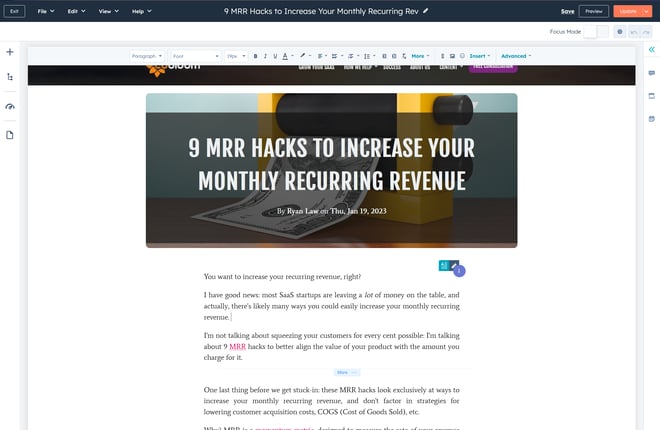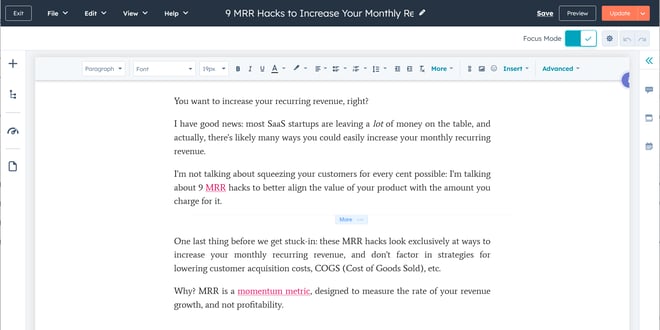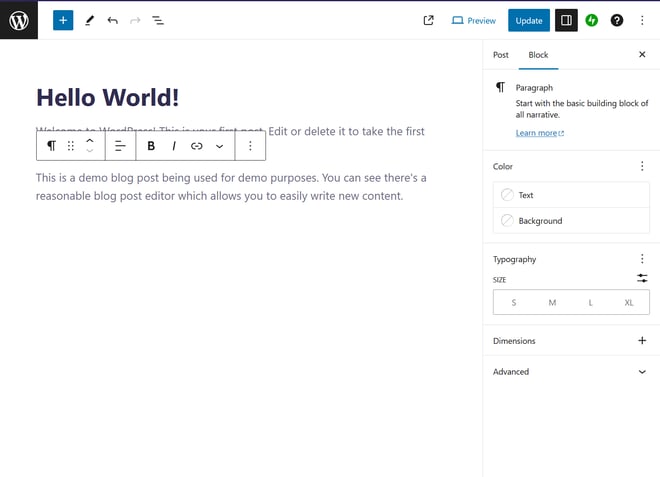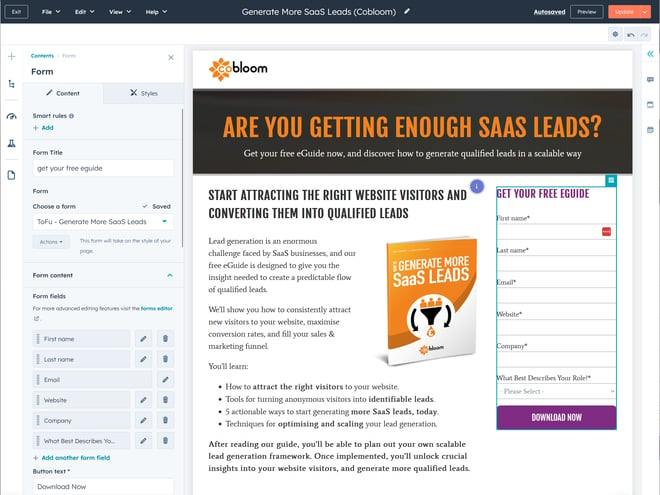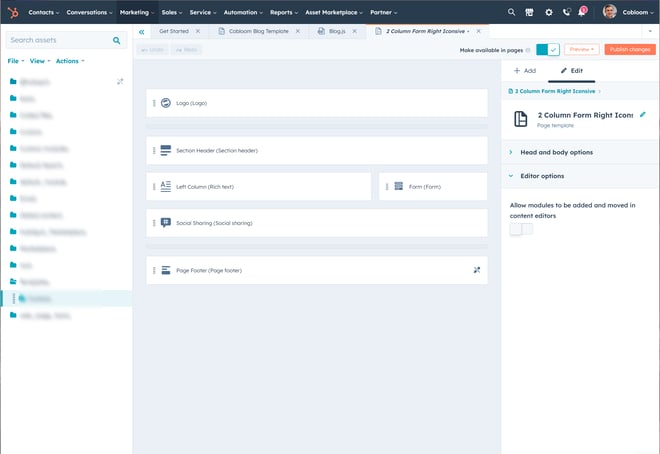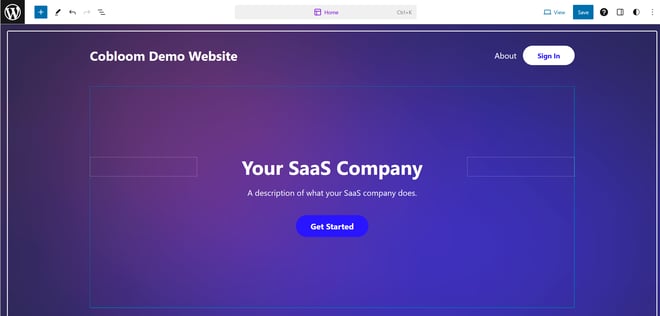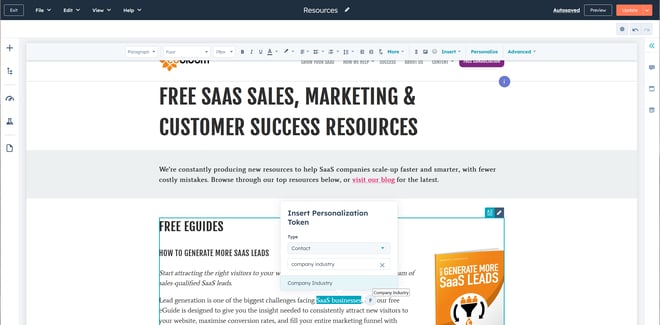Choosing between HubSpot Content Hub and Wordpress isn't immediately obvious for most companies.
HubSpot looks great, but is the software really worth the cost?
In today's post I draw on over ten years experience of myself and Cobloom using both HubSpot and Wordpress to make a comparison, and round-up with our recommendation for a typical business with growth ambitions.
Last updated in January 2025
What are HubSpot and Wordpress?
HubSpot
HubSpot is an all-in-one marketing automation platform. It's made up of six different hubs which integrate together and span Sales, Marketing & Customer Success. HubSpot's Content Hub was launched in 2013, and initially referred to as their COS (Content Optimisation System). The HubSpot COS was intended to be different to standard Content Management Systems, offering businesses the ability to build websites which were much better optimised for their target customers.
It's used by tens of thousands of companies to implement their marketing websites.
At Cobloom we've used HubSpot for about eleven years, and implemented it on behalf of companies ranging from a large organisation with tens of thousands of employees to small local businesses.
Wordpress
Wordpress is the world's most popular software for building websites, first becoming popular as blogging software in the early 2000's. The software is available as a free download, and completely open source. Anyone can get it from their website, upload it to a web hosting account and have a working website available within half an hour or so.
Wordpress is extremely flexible, and additional functionality can be acquired by installing themes and plugins from third party providers. Most themes can be bought as a one-off, but the majority of the best plugins require a monthly subscription.
Wordpress is used by hundreds of thousands of companies to host their marketing websites. It's basically the "default option" many go for when they choose a Content Management System.
Cobloom used Wordpress as our main CMS, when we were known as Iconsive (Iconsive re-branded to Cobloom in 2016). We've used Wordpress on its own, and in combination with HubSpot's marketing platform. Since 2005 I've personally built many Wordpress websites, in addition to managing our company's customers' Wordpress websites.
What's Right for Your Company?
Summary (TL;DR)
- The platform you choose for your marketing website is an important decision which impacts upon areas of your business you might not expect it to.
- HubSpot is better from an IT and security perspective. It usually won't require IT support which is as technical as Wordpress, and HubSpot doesn't require you to manage your own security.
- For most companies with a considered buying process (companies where their products/services are not an impulsive purchase, but typically require multiple weeks of consideration), HubSpot Content Hub is better for marketing.
- Early stage companies for whom a few hundred dollars per month is a lot of money have a tougher decision to make than established businesses, as HubSpot will often cost that much once you've got all the tools you want.
The Starter Customer Platform is very good value however ($15 per user per month), and recommended by us for small businesses as a way to get as much value as possible on a budget. - With Wordpress you can do a lot of what you can do with HubSpot's Content Hub, by installing plugins from third party providers. The problem with this approach is that each plugin you install introduces additional maintenance, complexity and security risks.
- Some companies find that once they've bought all the plugins they need alongside secure web hosting, that Wordpress isn't really much cheaper than HubSpot for a worse overall solution to their needs.
Blogging and Podcasting
HubSpot
HubSpot's Content Hub packages, ranging from the free tools to the Enterprise edition, all come equipped with a blog feature. Free and Starter users have the option to create 1 blog, while Professional and higher tiers allow for up to 100 blogs (though it's unlikely that most companies would require that many!).
The blog editor is user-friendly and intuitive, boasting a "What You See is What You Get" (WYSIWYG) editor that enables you to edit your blog post while simultaneously previewing how it will appear on your website:
Located in the top-right corner, you will find a button that enables "focus mode". This feature allows you to concentrate on your writing without any distractions from other parts of your website:
HubSpot offers the option to host your blog on either a subdomain or a subdirectory of your website. It's important to note that a subdirectory is only available if your main marketing website is also hosted on the HubSpot Content Hub. From an SEO perspective, a subdirectory is typically more beneficial, which is why we opted for this setup for Cobloom.
Within our HubSpot instance, we have two blogs - one focused on growth marketing and the other on career development & self-improvement - each in its own subdirectory.
In addition to HubSpot's blogging tools, Content Hub Professional now grants you access to a podcast tool as well. You can create podcast episodes in HubSpot by either uploading your own audio podcasts, or using their AI tools to generate audio from your written content. Out-of-the-box you can create up to five podcast shows, and record up to a thousand episodes.
Wordpress
Wordpress also comes with a built-in blog feature. Each Wordpress installation can host a single blog, so if you require multiple blogs, you will need to set up multiple instances. Similar to HubSpot, Wordpress has a user-friendly editor. While it may not be as WYSIWYG as HubSpot's editor, it is simple to preview how your blog post will appear on your website by clicking the preview link in the top right corner:
Your Wordpress blog can be installed in any subdirectory or subdomain you like.
There isn't any podcast functionality built into Wordpress, but there are a number of free and premium plugins available which make recording your own podcasts and publishing them to Wordpress possible.
Our Verdict for Companies
Both HubSpot and Wordpress are effective choices for a company's blogging/podcasting needs, especially if they only need a single blog. It's important to consider that if multiple blogs are required and Wordpress is chosen, multiple instances will be necessary. This can add complexity and bring about associated security and update risks that I will address later on.
If you go with Wordpress and want to create podcasts, you'll need a plugin for it.
Search Engine Optimisation
HubSpot
HubSpot's free tools and starter package ($15 per user per month) can help you optimise your website with basic SEO recommendations:
However, to get advanced SEO advice requires Content Hub Professional ($450 per month). The SEO advice it provides is prioritised, detailed and highly actionable.
Although our website is already well-optimised, there are still numerous SEO recommendations that we can address for further improvement, as highlighted in the example below from our Content Hub Professional instance:
The CMS platform is designed with SEO in mind, making it simpler for developers to create optimised websites right from the beginning.
Wordpress
Wordpress by default doesn't include SEO tools, but they can be installed easily enough using plugins like Yoast SEO (the most popular Wordpress SEO plugin). Yoast SEO is available for $99 USD per year.
While not as comprehensive as HubSpot's SEO advice, following Yoast SEO's recommendations can still lead to improved search rankings:

Wordpress comes equipped with solid SEO optimisation right from the start, and plugins like Yoast SEO offer a strong foundation for your website.
Our Verdict for Companies
HubSpot's Content Hub Professional offers top-notch SEO tools, which are crucial for companies that understand the significance of each ranking position for their targeted keywords. Moving from the second spot to the first spot for a target keyword can result in approximately 75% more clicks than before.
Companies which follow the SEO advice Content Hub Professional provides will usually find that the return on investment it offers will cover the higher cost, assuming they are targeting appropriate keywords.
While Wordpress will allow you to get started with SEO for a very low cost, you'll probably find that before long you want to integrate an additional third-party SEO platform like Semrush (starts at $139 per month).
Landing Pages & Forms
HubSpot
All versions of HubSpot Content Hub feature landing pages & forms that enable the conversion of anonymous website visitors into known contacts. Most companies will find they have the ability to create appealing and effective landing pages that yield high conversion rates with the Content Hub Starter package.
Content Hub Professional provides access to A/B testing functionality, which is valuable for optimising conversion rates, especially for landing pages with high traffic volumes.
Here's an example of the landing page editor in action, featuring a WYSIWYG editor similar to the blog tool:
You have the option to edit all landing page content, including title and metadata, and customise your form configuration using a user-friendly editor, as shown on the left side of the screen:
You have the ability to create landing page templates using the design manager, a feature that will be further explored in the following section.
Wordpress
Wordpress does not come equipped with a built-in landing page & forms editor, so to create landing pages, you will need to utilise a third-party plugin or hire a developer. For a landing page editor similar to HubSpot's Content Hub Starter, you can use SeedProd, which costs approximately $200 per year for the necessary package:
Other popular plugins people use to build landing pages include:
- WPForms (starts at $49 per year -- you may require the assistance of a developer to create your landing pages, even for basic forms)
- Unbounce (starts at $99 per month for up to 20,000 monthly visitors, providing access to advanced marketing features found in Content Hub Professional, particularly in its Optimise & Accelerate packages.)
It's important to note that the integration of these tools may have an impact on your SEO. When using a tool outside of your CMS like SeedProd or Unbounce, hosting your landing pages on a subdomain could lead Google to view them as a separate website.
Our Verdict for Companies
Most companies will find that HubSpot is an easier solution for their landing pages & forms than Wordpress is. Landing pages are not included by default in Wordpress, so in order to access the necessary functionality, you will need to utilise additional plugins or seek assistance from a web developer whenever you (or your marketing team) wish to create a new landing page.
Throughout this comparison, you'll see a recurring theme that many of the features HubSpot offers can also be achieved with Wordpress. However, it's important to note that the more plugins you add to your Wordpress site for additional functionality, the more complex it may become to manage and the higher the potential security risks you'll encounter.
Website Design
HubSpot
The centralised design manager in HubSpot Content Hub allows you to easily customise your webpage, blog, and landing page templates. You have the option to create your page templates using their user-friendly drag-and-drop editor (this is not WYSIWYG in this case, for reasons of flexibility):
Or code editor, for those of you with web development experience or a developer who will support your marketing:
HubSpot has developed their own templating language known as HubL, which is clearly demonstrated in the coded template above enclosed within the double braces. The templating language is designed to be easily understood by experienced web developers, thanks to its intuitive nature.
HubL simplifies the process for developers to incorporate dynamic content into templates, allowing for the creation of themes that stretch across multiple templates while maintaining clean code.
When creating pages, you have the flexibility to use a combination of the code editor and drag-and-drop editor for any template. This makes it simple for marketers who may not be developers to easily insert coded blocks into their pages, a feature that many companies will find valuable.
HubSpot offers a wide range of theming, templating, and web development tools that seamlessly blend user-friendly features for non-developers with powerful tools for experienced developers looking to create advanced websites.
For those with web development experience or a web developer on their team, we suggest exploring the Design Manager docs to fully grasp the extent of HubSpot's customisability from a design and development standpoint.
If you want to browse an example of a website built entirely on the HubSpot Content Hub, take a look at swipedon.
Wordpress
Wordpress offers a user-friendly drag-and-drop WYSIWYG tool for creating page templates, known as the block editor. Its functionality closely resembles that of HubSpot's drag-and-drop editor. You can view a demo example we have prepared here:
Wordpress offers a wide selection of pre-designed templates right out of the box, and one of its key strengths is providing a vast array of options available through theme websites like envatomarket. If you are comfortable using a pre-made template for your company website, Wordpress offers a quick and efficient way to establish your online presence, with a wider variety of templates readily accessible compared to HubSpot. However, it is important to note that using third-party themes may result in other companies using the same design, potentially diluting your brand identity if customers become aware of it.
Similar to HubSpot, Wordpress also allows for direct updates to theme and template code by a web developer, granting you the same level of flexibility as with HubSpot. Most web developers typically connect to their Wordpress instance via FTP or a similar method to make direct edits to files from their local development environment.
Although Wordpress lacks a templating language like HubSpot's HubL, your web developer can implement a templating engine using PHP or directly modify PHP code to achieve similar results, albeit in a more complex manner when necessary.
Our Verdict for Companies
Both HubSpot's Content Hub and Wordpress offer the capability to create visually appealing and high-performing marketing websites for your company. With compartmentalised code and template building blocks, both platforms allow individuals without web development experience to easily create and edit templates and pages without the need for a web developer.
HubSpot and Wordpress each have a supply of templates available out-of-the-box you can use to deploy a website quickly with, but Wordpress overall has the wider selection due to its huge ecosystem of template builders. Most companies choose to either heavily modify a basic framework template or design from the ground up to build a strong brand and marketing website, and either platform can be used to do this.
In our experience, most web developers and marketers prefer working with HubSpot over Wordpress once they've used it for themselves for a while.
Smart Content and Personalisation
HubSpot
HubSpot Content Hub includes smart content and personalisation functionality in HubSpot Content Hub Professional and above. What exactly is smart content? Smart content refers to the content on your webpages that is controlled by "smart rules." This feature enables you to show dynamic content to visitors based on factors such as their geographic location, ad source (UTM parameters), device type, preferred language, and more.
For known contacts who have already completed a form on your website, HubSpot enables you to customise website content based on their contact attributes. For instance, you can adjust the content on your free trial page to cater to the preferences and needs of a sales representative versus a VP of Sales.
Here's an example of us adding some smart content to our "Resources" page, which changes the content block based on whether they've previously shown an interest in one of our in-person pricing workshops or not:
In addition to smart rules, you can also personalise the content of pages using personalisation tokens (attributes stored against contacts in your database).
On the "Resources" page we might do this to replace where we've hard-worded SaaS, so that if a known contact in the manufacturing industry viewed the page, they'd see "manufacturing businesses" instead. You can then set a default attribute to display when the attribute isn't known, such as "businesses like yours":
You can utilise smart content and content personalisation on website pages and landing pages, but not on blog posts. It's important for businesses to use these features thoughtfully, as overdoing it could potentially drive away visitors. (You might now wonder how much we personalise our content, for example! We use the feature sparingly, as you can test for yourself if you try filling in one of our forms, such as our free lead generation eGuide -- you can opt out any time)
When used correctly, smart content and personalisation makes the overall experience of your website better for the visitor, helping them to get useful information from your website as fast as possible.
Wordpress
Wordpress does not come with built-in smart content or content personalisation features. To achieve similar functionality, you may need to utilise a tool that dynamically adjusts your content with javascript, which could potentially have implications for SEO. There are tools available, such as VWO, that can assist with this process. VWO is a tool we have utilised in the past when we were unable to implement smart content or personalisation directly using HubSpot.
VWO starts from $200 per month for the functionality you'd need to implement smart content or personalisation. You will also have to connect VWO with a CRM or Customer Data Platform to adjust content based on contact information from form fills, which will require the expertise of a web developer and involve a considerable level of complexity.
Our Verdict for Companies
This is an area where HubSpot really excels, as equivalent functionality is virtually impossible to achieve even with Wordpress plugins. Solutions like VWO add complexity and risk harming your SEO without providing a complete solution.
If your marketing website is expected to attract a substantial amount of traffic (exceeding a few thousand visits per month), you will discover that this feature of HubSpot Content Hub holds significant value. When executed effectively, smart content and personalisation can enhance both your conversion rates and the average duration visitors spend on your site.
Security & Reliability
HubSpot
HubSpot is mostly closed source and they provide your cloud hosting, which means they're responsible for maintaining your CMS' security. Hosting more than a hundred thousand business websites, they take security incredibly seriously. You can read their latest (as of this post) security & compliance overview here. (Although to warn you, it's a quite technical 23 page document... Perhaps one to sit-and-read with tomorrow morning's coffee!)
In our eleven years' experience of working with HubSpot, we have never experienced a security incident which has impacted us, or anyone we know/work with. As far as we are aware, HubSpot has never experienced a major security incident.
Users do need to be aware of keeping their account credentials safe & secure, and HubSpot offers features like two-factor sign-in to help with this. In the unlikely event that your account was ever accessed by someone who shouldn't have access, HubSpot takes regular backups which can be used to restore your account or any changes made.
When it comes to reliability, we've never had an issue here either. HubSpot is designed so that it's available and accessible even in a variety of disaster scenarios. You can read more about the many steps they take to ensure your account and website are always accessible in the security & compliance overview referenced above. HubSpot targets a minimum 99.95% service uptime (less than an hour's downtime each year).
Wordpress
With Wordpress you'll need to follow password best practices for your Wordpress account itself, just like with HubSpot. It's wise to enable two factor sign-in within your account to reduce the chances of someone logging into your account were they to get access to your password.
Security is Wordpress' biggest weakness. Due to being opensource and used by millions of websites worldwide, it's a huge target for hackers and faces regular attacks and exploits. If you use Wordpress it's therefore essential that you regularly update your Wordpress instance to the latest version, to reduce the risk of being hacked.
Not only do you need to worry about Wordpress, but every plugin you install also adds potential new vulnerabilities to your entire website, due to the way their plugin system works. This means that you need to simultaneously keep all your plugins up-to-date, and are reliant on the development teams of any plugins you use responding to security issues in a prompt manner.
Many Wordpress plugins are operated like hobby businesses rather than professional organisations, which means you need to pay very careful attention to anything you're installing.
Finally, when you choose to use Wordpress you're also vulnerable to any security vulnerabilities that may exist within the web hosting provider you choose, which makes it vital you choose a secure and reliable provider. Anyone can start and run a web hosting business (google "reseller web hosting account" if you want to get started!), and there are huge variants in their professionalism.
Our Verdict for B2B Companies
When it comes to security and reliability, HubSpot is a clear winner.
Conclusion
Most companies will find that HubSpot is the best overall solution for their marketing website's requirements, especially since the introduction of HubSpot's Starter Customer Platform for small businesses at $15 per user per month.
More established companies will find that HubSpot Content Hub Professional usually fulfills their requirements, which includes 3 seats, at $450 per month.
Out-of-the-box HubSpot has better capabilities across a number of important areas, especially from a security & marketing perspective.




